马上注册 家电论坛,众多有奖活动等你来参与!
您需要 登录 才可以下载或查看,没有账号?注册

x
[table=98%][tr][td]Technical ones background and first solutions
to the problem removal…[/td][/tr][tr][td=1,1,31%][/td][/tr][tr][td][/td][/tr][tr][td]
Now is it finally so far: Both Blu ray and the HD-DVD - standard on the German market arrived. Thus will it for the home cinema fan now finally possible to come into the HDTV benefit with full dissolution (1920x1080) completely without the slow-acting, conservative and over-economical TV organizations, which worry only few in this country about innovations and rather our GEZ fees aging and useless over-paid “Showmastern” leave.
Appropriate screen/Beamer presupposed, offers both standards, which buhlen around the market leader shank and follow-up of the DVD, a substantially higher image definition, fewer artifacts and to better clay/tone than all past purchase media for home videos. The prices are fair thereby particularly in case of the HD-DVD more than, then fast success among enthusiasts does not surprise.
In our mega+ Special we already confronted both standards on over one hundred sides. It turned out that they are technically actually inferior themselves in nothing, but at the software new compression variants the nose in front to have. Thus the race remains more than openly and excitingly.
But beside all the advantages in the last weeks increasingly a “new” phenomenon of both standards is discussed, with which we were so far not confronted in Europe and its PAL standard. Is meant the “3: 2 Pulldown”, which a certain Bildruckeln in gleichmässgen motion provokes. While Americans and Japaner appears themselves already long to it to have accustomed, it for many Heimkinfans here as nearly unreasonable picture artifact. Why wasn't there the problem in this country so far? Where does it lie justified? Is there remedy and if, how one realizes her? All these are questions, which we want to answer in this large Special…
Table of contents:
1. - The liquid PAL (Interlaced)
1.1 the PAL system: Representation in half-images
1.2 similar Zellulloid Filmmaterial, represented over PAL
1.3 progressive Scan - PAL in full dissolution
1,4 De-Interlacing of Filmmaterial
1,5 Zusamenfassung: Our past PAL standard
2. The NTSC standard: 60Hz instead of 50Hz
3. HDTV with Blu ray and HDVD: Original cinema frequency on the Silberscheibe
3,1 HDTV 50Hz, not the solution?
3.2 the measure of the things: 1080p/24
3.2.1 hardly a display/a Beamer supports the original cinema frequency
3.2.2 HD-DVD Player and none Blu ray Player does not support at present the original cinema frequency
3.2.3 1080p expenditure, the goal however not the rule
3.2.4 Second generation Player with 24p expenditure
4. Remedy: External video processors of renowned marks
4,1 De-Interlacing of 1080i/60Hz - signals
4,2 Reverse Pulldown for 1080/60p
4,3 48Hz rendition, sometimes the solution
5. Practice test: Two high-quality Scaler with HDTV Reverse Pulldown
5,1 DVDO iScan VP50
5.1.1 1080i - > 1080p De-Interlacing
5.1.2 1080i Reverse Pulldown
5.1.3 1080p Reverse Pulldown
5,2 Crystalio II VPS3300
5.2.1 1080i - > 1080p De-Interlacing
5.2.2 1080i Reverse Pulldown
5.2.3 1080p Reverse Pulldown
6. Result
1.0 - the liquid PAL (Interlaced)
In order to describe the phenomenon of the “new” Bildruckelns, we start with our PAL standard. Because just with our “old” transmittal mode the problem of the Bildruckelns did not arise with features. Is PAL its time ahead?
1.1 the PAL system: Representation in half-images
The PAL system is already many decades old and is subject to accordingly numerous Limitationen. Its vertical dissolution amounts to 576 lines during the DVD rendition. This dissolution is acceptable in the reason, but a large restriction results from the used interlaced scanning (Interlacing). Here first all odd lines (1, 3, become 5,…) and afterwards all straight lines (2, 4, 6,…) the picture transfer. The lines not transferred at the moment in each case remain black.
The representation of these so-called “half-images” repeats itself 50 times per second. The vertical dissolution is halved by this optical trick. This remains to a large extent unnoticed by the inertia of the eye with standing objects.
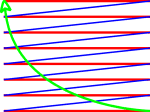 Alternating line transmission
Alternating line transmission

Two successively transferred half-images result in a frame

The bananas franzen with movement (e.g. from right left) out
Further become details, which are so small that they appear only in a line, with each second half-image “swallowed”. They dive thus alternating on and:
The hair on the Kiwi is so small, which a large part is swallowed in half-image 2 (right). Also in the cut open part details are missing. These details begin to flicker by the alternating representation. The effect is called “LINE Twitter”.
1.2 similar Zellulloid Filmmaterial, represented over PAL
During the film overacting on video each film picture is converted into two following each other half-images: First with all odd lines, second with all straight. This procedure calls itself 2:2 Pulldown:
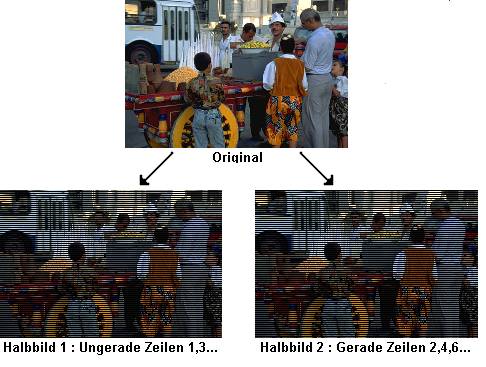
2:2 Pulldown
From this trick an easy rise (approx. 4%) of the Filmgeschwindigkeit results. A film, which e.g. exhibits Lauflänge of 100 minutes in the cinema, has a length of 96 minutes, the film in the Homevideo edition only runs somewhat too fast. But this difference is to be noticed extremely small and only in the direct A/B comparison. However also the clay/tone 4% runs too fast, which disturbs some home cinema enthusiasts.
1.3 progressive Scan - PAL in full dissolution
Progressive Scan is an advancement, which eliminates the half-image rendition of the conventional PAL of signal. Instead of 50 half-images (288 lines) per second now 50 frames with in each case 576 lines are shown. The vertical dissolution is thus doubled. Thus the transferred picture of clearly clear and more detailed appears. Also the annoying line flares is missing any longer. Progressive Scanning is in the computer range since years standard (each VGA monitor works progressively) and has also by the DVD technology increases introduction into the home cinema world taken.
For the home cinema projection the progressive signal is to be preferred to the Interlaced signal independently of the used type of projector by its higher detail loyalty in any case.
By this “extension” of the image output the raw material must, speaks video signal, to progressive Scan to be converted. Perhaps this procedure is called “De-Interlacing” and turns out as extremely complex. (By the way: Progressive Scan improved only the dissolution, any other picture characteristics such as contrast, color etc. remains unaffected).
1,4 De-Interlacing of Filmmaterial
Filmmaterial is divided, as above described, in 50 half-images per second, two half-images a film picture is devoted built up: This building up must be made thus during the progressive rendition of the appropriate devices digitally. The DVD Player and/or TV or projector takes two successive half-images, twists it to a frame together and spends the picture. This so-called “Weaving” sounds extremely simple in the theory, can result in numerous problems in practice however.
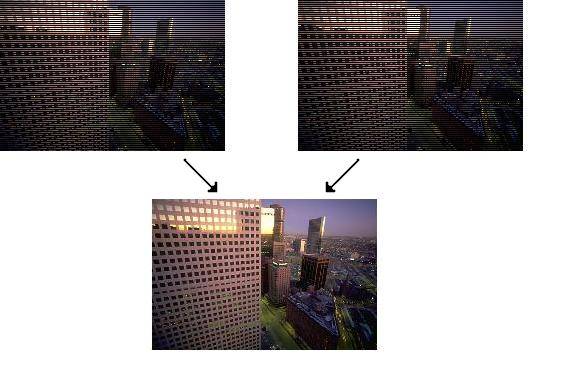
“Weaving”: From two video half-images progressive picture is made
For a perfect progressive picture the De-Interlacer must know however, which on the DVD noted half-images as original film picture to belong together. But special algorithms are necessary, the Filmmaterial “recognize”. Some newer and qualitatively good projectors/plasma already have such internal “film mode” recognition and join the half-images to original Filmframes. Depending upon quality of this recognition no large difference between the use of a conventional Interlaced DVD Players and progressive DVD a Players results.
A good progressive DVD Player in most cases works however better and more stably, those dissolution is not easily impaired, since he works directly digitally. In addition the DVD Player has the so-called DVD flag for the analysis of the pictorial material for order.
1,5 Zusamenfassung: Our past PAL standard
In the result we hold: PAL is optimized in no way on similar cinema material: The dissolution is subject clearly to the Potenzial of 35mm and/or 70mm Filmmaterial, the transmittal mode by half-images makes numerous necessarily cheats and difficult algorithms. The only reason, why PAL does not exhibit with features disturbing Ruckeln, is the coincidence that we have a tension frequency of 50Hz in our electricity mains in Europe. 50Hz does not have any common multiple and also no divisor with the 24Hz of the cinema, so that the 25Hz trick (see above) is used. But this has the disadvantage that the film runs off easily too fast, under what above all the clay/tone (too high) suffers. As perfect the solution cannot be regarded therefore.
2. The NTSC standard: 60Hz instead of 50Hz
In the USA and Japan the thing looks differently: Instead of 230V with 50Hz, fit there in electricity mains 120V with 60Hz. For this reason with the NTSC video standard was selected not 50Hz (as with us) as image frequency, but 60Hz. This changes the solutions for the video representation of Filmmaterial uncommonly.
Like our PAL standard also the NTSC standard functions after the Halbbildverfahren. The straight or odd lines will transfer in each case. The vertical dissolution is thereby clearly smaller than with PAL, it amounts to only 280 lines. The NTSC standard through fewer picture flares makes up for the disadvantage of the smaller dissolution and liquid movements, at least which concerns video material. Because the representation of Filmmaterial is importantly more difficult: As already described Fimmaterial in cinemas with 24 pictures per second (24Hz) works. The NTSC standard “needs” however 60 half-images/second and/or 30 frames/second. 6 pictures/second are therefore missing. With PAL it was only 1 picture/second, so that small acceleration could be taken on 25 pictures/second straight still in purchase. An acceleration of 24Hz on 30Hz was however not possible, with it the film whole 25% too fast would nevertheless run off. Another solution had thus ago, in order to make Filmmaterial with the NTSC standard representable. Simple mathematics came to the assistance:
If one divides each cinema picture, as described above, into two half-images, then one receives already 48 half-images per second (=48Hz). Still further 12 half-images are thus missing, in order to make the 60Hz full. 12 is however a glücklichwerweise divisor of 24 (cinema frequency). If one comes up thus each second cinema picture not only doubled on two half-images, but trebled on three half-images, then the calculation exactly:
24 x 2 + (24: 2) = 48,+12 = 60 Of course a certain Rhytmus must into the screen sequence: One decided to represent each first cinema picture three times each second twice. This explains “3 to the names: 2 Pulldown”. With the help of our picture pattern the expiration becomes clearer:
 Double pictures are hinzugeschummelt by the Pulldown
Double pictures are hinzugeschummelt by the Pulldown
How one can infer from the pattern, some half-images appear simply double on the screen. It is easy to see that thereby liquid movements begin too stottern and the typical Pulldown Ruckeln inclusively-calibrates itself. This is inevitable during a representation with 60Hz, thus lives therefore Americans and Japaner since then it home video gives.
3. HDTV with Blu ray and HDVD: Original cinema frequency on the Silberscheibe
Why ruckeln now the new Hp-DVDs and Blu rays in this country so, how the American NTSC overacting? This sounds rather after backward step after technical progress. The phenomenon actually results from partly meaningful decisions in the case of the standard and partly technical inadequacies of past products.
3,1 HDTV 50Hz, not the solution?
HDTV is not calibrated on a firm frequency. While to the USA and Japan 60Hz also for HDTV were transferred, would be obvious to this pattern for Europe according to 50Hz. With 50Hz the standard was also introduced, first HDTV transmitter, like e.g. PremiereHD, used HDTV/50Hz. Accordingly jerk ELT with feature transmissions also nothing, it run however, as with PAL, with 5% increased Geschwindikeit at 25 pictures/second.
Now it would not be also possible, for feature Hp-DVDs and Blu rays with 50Hz/25fps to mastern, these large conversion in relation to our past PAL standard would constitute. But manufacturers and Filmstudios decided against it: One wanted to divide but uniformly for the whole world introduce the new condition wheel nich further into cycle per second regions. This has also economic reasons, is finally sufficient such only one mast ring for the whole world. Therefore one decided, exactly the image frequency from the cinema, 24Hz, to store on the feature disks. This Entscheidnung is comprehensible and makes sense technical. Original-faithful storing of the individual cinema pictures offers the best starting point for an optimal image quality.
3.2 the measure of the things: 1080p/24
This starting point can be used however so outstanding only if the entire home cinema chain supports an appropriate standard. Ideally the HD-DVD continues to give and/or Blu ray Player the original 24 cinema pictures progressively to the Beamer, which projects these likewise individually with 24Hz on the canvas. This standard was specified, it is called also “1080p/24”. With him one achieves the optimum image quality without compromises. But in practice it gives at present a few “hook”:
3.2.1 hardly a display/a Beamer supports the original cinema frequency
Like pretty often, one decided very at short notice for the 1080p/24 standard. One year ago was still hardly the speech of it, why only the few manufacturers this topic took care of. The receipt always gets like the customer: Hardly a Beamer and as well as no flat TV supports HDTV/24, to be processed usually only HDTV 50Hz/60Hz. But hereby the problems result: Since on the disk 24 pictures are stored, a conversion on 50Hz is not possible by the Player. But the cost of computation would much too highly particularly be in real time, for the clay/tone. It remains only changing over to 60Hz, which entails however the Pulldown Ruckeln described above.
Result: Who calls a plasma or a projector with “only” HDTV 50Hz/60Hz its own, which must HD-DVD and Blu ray with jerk-learn to look, it leads past no way! Only with new devices the new standard is slowly supported, but this is at present no guarantor for a ruckelfreie representation:
3.2.2 HD-DVD Player and none Blu ray Player does not support at present the original cinema frequency
So paradoxically it sounds: Although on the disk the sinvollerweise original cinema pictures are stored in their original frequency, at present no Player is in this country in a the position to spend these natively. This sounds nevertheless like the technically simplest solution. In practice is this unfortunately different: Also the few decoder chips, which are available at present and are blocked in the Playern, limp to the standards afterwards and are optimized on a conventional 60Hz rendition. In other words: They do not support 24p likewise. As result all show HD-DVD Player of motion picture films so far in Germany available Blu ray and only in 60Hz, with all Ruckel disadvantages described above. Only light view is unfortunately American Sony Blu ray Player, which supports the 24p expenditure as the first equipment, but, as surprisingly, in this form probably not in this country will appear. But thus enough, the decoders do not permit not even a progressive selection of the pictures:
3.2.3 1080p expenditure, the goal however not the rule
The theory sounds so simple also here: The 24 pictures/sec. of the disk pick out and without large modulation progressively to the display pass on. But again decoder chips make a line by the calculation, since they support only the Halbbildverfahren. In order to make a 1080p possible expenditure, how they nevertheless offer the first Blu ray Player, therefore additional De-Interlacing is necessary, with all the problems, which admits since more jeher with PAL and NTSC is. Also the Pulldown problem is not solved by a progressive representation, since only 1080p/60Hz is supported at present. Instead of doubling half-images, with the progressive expenditure each second frame is trebled:
The only difference is that here whole frames are repeated. Therefore ruckeln 60p representations exactly the same, like 60i representations.
3.2.4 Second generation Player with 24p expenditure
Meanwhile also the manufacturers recognized the bad state and to want with the Playern of the next generation the original cinema frequency to support. So is to have the coming 1080p HD-DVD Player of Toshiba a 24p expenditure, likewise the 1080p announced by Pioneer Blu ray Player. But who thinks the fact that these models read directly the 24p of the disk which errs. Also in these devices only aufwändige electronics from the signal filters the desired 24Hz cinema frequency. It is thus not amazing the fact that a 24p expenditure so far more expensive “High ending” - variants is reserved. Besides the projector or the display must be able to process also 24p of signals. As previously mentioned: If the projector supports only 50Hz or 60Hz, then there is no solution for the Bildruckeln. Also 48Hz Player will probably not give it in the next generations for the time being, although many projectors still support this frequency contrary to 24p.
As this chapter shows, the devices, both with the Playern and with the televisions/Beamern, limp to the standard at present afterwards. They are usually not in a the position, the optimum, 1080p with 24Hz to spend or process. The consequence is the disturbing Pulldown Ruckeln, which seems inevitable at present. Doesn't one have to thus wait, until the first 24p Player comes on the market, gives it a solution to enjoy the film exactly as in the cinema? Fortunately there are various accessory manufacturers, that took care of the topic and solutions to compile at present and offer, partly with more, partly with less success:
4. Remedy: External video processors of renowned marks
If it cannot the Player, one must achieve its goal by additional treatment of pictures. This work is taken over by external video processors or Scalern. Home cinema High Endern these are for a long time well-known. Pretty often the spezialiserten devices achieve better results in the De-Interlacing or in the scaling, as in the comparison favorable Consumer products. Therefore are Scaler nearly already as old, as the grossbildprojektion at home. Now they get a new field of application due to above problems: Reverse Pulldown for hp material!
In this chapter we give an overview of how one can solve the problem of the Ruckelns at present technically. Please you note that this is possible only if your TV or projector supports a 24Hz or a 48Hz rendition!
How is it possible to reconstruct the original 24 progressive pictures of the storage medium if these are not adequately spent? Depending upon source the external Scaler has two fields of application:
4,1 De-Interlacing of 1080i/60Hz - signals
With 60Hz signals that has to fulfill the De-Interlacer with Filmmaterial two things: It must interlace, as with PAL, two fitting half-images to a frame, segregate additionally however still the surplus, double half-image.
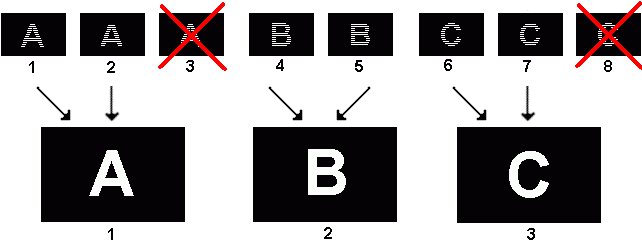 Correct 1080i/60Hz De-Interlacing:
Correct 1080i/60Hz De-Interlacing:
In each case two matching half-images are interlaced to a frame,
surplus half-images “are deleted”
This task is not so simple, as it seems: The Scaler must accomplish an image analysis in real time (= 60x/sec.), which correct Rhtymus finds and which correct pictures join and/or cut out. Per picture it has therefore only approximately 16ms time. It is about particularly difficult to keep Timings exactly. Already minimum deviations provide for Bildruckeln. Besides only once a wrong picture is cut out, the Rhytmus can be hurt sensitively. The transformation of 1080/60i on 1080/24p belongs to the aufwändigsten tasks, which a Scaler has to fulfill at present. It is a little simpler with fed 1080p/60Hz - signals:
4,2 Reverse Pulldown for 1080/60p
If one already feeds the Scaler with progressive pictorial material, then the task is visibly facilitated for him. It must decide now no longer even, which half-images are redundant and which half-images result in a cinema picture. The task is limited to segregate surplus frames. Since with 1080p material is twice represented after 3:2 Pulldown each cinema picture, and each second even three times, is dei task more easily. The Scaler must recognize “only” each image regeneration and segregate all double pictures.
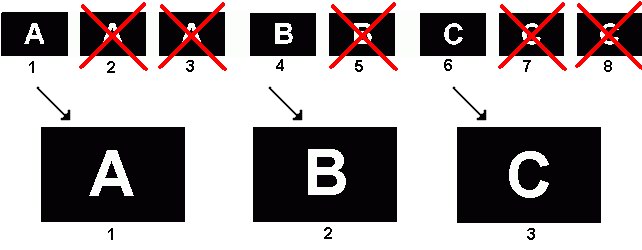 Reverse Pulldown for progressive Filmmaterial:
Reverse Pulldown for progressive Filmmaterial:
All image regenerations are deleted
特别注意这段:)4,3 48Hz rendition, sometimes the solution Vorraussetzung for above variants always is that the projector can also process the new picture fig. “24p ". If it cannot do this, both procedures are not applicable. If one has luck, there is however a “Workaround”: Some Beamer with particularly flexible signal processing does not understand 24Hz of signals, but 48Hz of signals, how they can be produced by each PC and with HTPC for years are usual already. The frequency of 48Hz has the advantage that it represents a whole multiple of the cinema frequency (doubled frequency). It is enough thus to double each frame simply.
From the simple doubling no Bildruckeln results. 48Hz are for native 24Hz material the same, as PAL for 25Hz material (see above). But the 48Hz representation unfortunately belongs to no official video standard, why she is spent by no present Player and also with future models probably is not supported.
Fortunately Scaler manufacturers adhere not completely so stubborn to official standards, why high-quality models support a 48Hz-Übertragung. With the Reverse Pulldown and/or De-Interlacing the frames are doubled and passed on twice in each case to the projector. This solution is inferior the 24p transmission in nothing, as long as the frequency can be shown by the projector/TV without disturbances.
5. Practice test: Two high-quality Scaler with HDTV Reverse Pulldown
So far, we Scaler have the theory on their efficiency examined for this Special two particularly admitted and renowned. Because finally only practice on the canvas counts:
5,1 DVDO iScan VP50
Lately a Scaler particularly made for speeches from itself: iScan the VP50 from the house DVDO. It offers a high-quality VRS signal processing from the house Anchor Bay Technologies.
Of course such a video processor offers also innumerable functions and possibilities of the picture adjustment and improvement. In a detailed report we will in the future treat all aspects of this model. This know-how Special we are limited to HDTV De-Interlacing and Reverse Pulldown.
The processor is ground in simply over one of its numerous entrances into the signal. Over its exit it passes the signal on to the projector. A pleasant Nebenenffekt participates that such a Scaler can be used also as practical change over switch, which besides on an exit (e.g. HDMI) changes all signals. But back to the topic: After the installation menu of the Scalers the desired dissolution can be selected in the OSD.
As one can infer from the screen SHOT above, the processor offers innumerable dissolution variants and repetition frequencies.
In a further menu the user programs, how detailed signals are processed. We determine that 1080i/60Hz material, how it is supplied at present e.g. by HD-DVD on 1080p/24Hz is to be changed.
Thus we would be already finished with the preparations. With various film scenes, passed on of a Toshiba Hp-DVD-Player HD-XA1, we took now the quality characteristics of the VP50 more exactly under the magnifying glass:
5.1.1 1080i - > 1080p De-Interlacing
The topic is as old, as the DVD: Progressive Scan DVD Player goes meanwhile into the x-width unit generation, and still there are no perfect solution, which works in each film scene always perfectly. This is a reference point, as complex a good De-Interlacing is actual. With HDTV we have to do it now still additionally with an increased dissolution and a double number of lines, what does not facilitate the task straight.
The VRS signal processing iScan of the VP50 showed a solid achievement in our tests: Also in finely structured scenes the processor set small details akkurat together, disturbing flickering or interference sample was however present in parts the rarity. Here and there diagonal edges showed easy stair formation or fine structures a picture unrest, which home cinema perfectionists can notice. There are thus still Potenzial upward, yet worked the De-Interlacing of the VP50 on a very high level, which leaves reason only rarely to the complaint. It is definitely an picture-improving alternative opposite most internally blocked De-Interlacern in televisions or projectors.
5.1.2 1080i Reverse Pulldown
iScan the VP50 is one of the few, if not even the only Scaler, which can at present alternatively change detailed 60Hz of signals in 24Hz or 48Hz and a Reverse Pulldown accomplishes. We started with the 24Hz expenditure: The processor recognizes the Filmmaterial in fractions of seconds and accomplishes an adequate De-Interlacing. At the same time it changes the disturbing Ruckeln on 24Hz, reliably disappeared. It is already a satisfaction to admire HDTV in full quality without restrictions on the canvas. Who got accustomed only once to the liquid Bewegungsabfläufe of the 24Hz rendition, the 60Hz Ruckel variant appears increasing unreasonable.
But where light is, is also shade: With our test occurred it again and again once that the Scaler lost its Rhytmus, disturbing Ruckeln was the result. Remedy creates a short Pausieren of the film, thus the Scaler synchronizes again and the picture runs again liquid. It is annoying nevertheless to pausieren a film until twice.
Easy weaknesses showed up also with fast picture changes: Particularly when flashing, e.g. with thunderstorm scenes, here and there fast a cinema picture was jumped over, which makes itself visible in a short Ruckeln.
We went over to 48Hz, here remain the picture still more stably in the Rhytmus, but the Ruckler in parts and/or only the Sync which can be corrected by Pausieren also here still occurred.
5.1.3 1080p Reverse Pulldown
As already in the run this Specials describes, the Reverse Pulldown for 1080p becomes at least theoretically somewhat easier, than with 1080i material. iScan the VP50 seems to confirm this in practice. In order to examine its achievement with 1080p material, we switched to Samsung Blu ray a Player, which inserted its own Faroudja processor for the 1080p expenditure.
The VP50 with 1080p signals actually shows impressing achievement: Isolated Ruckler does not exist also with fastest camera cuts or flashlights to no more, the picture runs always liquid as in the cinema. Also losing the synchronisation is now an absolute rarity. On average it occurred only once per film, sometimes goes through a film also completely, without one is forced only once to tracing branch. Now and then it happened however nevertheless with our tests.
The DVDO iScan VP50 is a payable solution, which offers already a good remedy against the disturbing 60Hz Ruckeln of the new media. Good De-Interlacing and an efficient Reverse Pulldown let the spectator come the genuine cinema experience more near. But perfectly is not the solution at present unfortunately yet. The misfires in parts with 1080i material cloud the otherwise good general impression and stir up the demand for a software update. And the update is after our information also in work, so that here still further improvements are to be expected.
5,2 Crystalio II VPS3300
Second High ending processor, which we looked at more exactly, the Crystalio II is, that with a price between |
 /1
/1 
 京公网安备 11010602010207号
( 京ICP证041102号,京ICP备09075138号-9 )
京公网安备 11010602010207号
( 京ICP证041102号,京ICP备09075138号-9 )